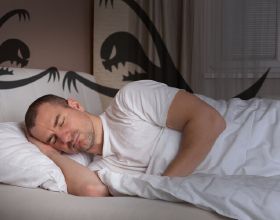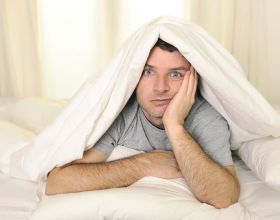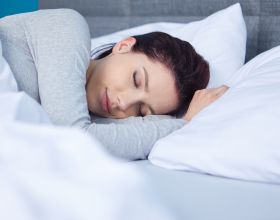來源:中國日報網
夜夜難以入眠,害怕身體吃不消?研究發現,睡眠不足可以靠運動來補。只要運動量達標,即使睡眠質量差,也可以抵消不良睡眠帶來的健康風險。
Staying active and fit could help to ward off some of the negative health impacts that would normally result from low-quality sleep, according to a large study of 380,055 middle-aged people involved in the UK Biobank research project.
英國生物庫研究專案的一項涵蓋了380055名中年人的大型研究表明,保持活力和健康有助於抵禦通常由低質量睡眠導致的負面影響。
We all know that a healthy life means getting both plenty of exercise and enough good-quality sleep, but reality often gets in the way. The new research indicates that doing enough exercise could make up for some of the unhealthy impacts of bad sleep.
我們都知道,健康的生活意味著既要有大量的運動,又要有足夠的優質睡眠,但現實總是有諸多阻礙。新的研究表明,做足夠的運動可以彌補不良睡眠帶來的一些不健康的影響。
While the health benefits of exercise and sleep are nothing new, it's the relationship between them that is interesting in this particular study - it could even give doctors another option to suggest for patients dealing with sleep problems.
雖然運動和睡眠對健康有益的觀點並不新鮮,但是這項研究的特別之處在於運動和健康之間的有趣關係,這種關係甚至為醫生提供了治療患者睡眠問題的另一種方式。
'We found those who had both the poorest sleep quality and who exercised the least were most at risk of death from heart disease, stroke, and cancer,' says epidemiologist Bo-Huei Huang, from the University of Sydney in Australia. 'The findings suggest a likely synergistic effect, an interplay, between the two behaviors.'
澳大利亞悉尼大學的流行病學家黃伯輝(音譯)稱:'我們發現那些睡眠質量最差、運動最少的人死於心臟病、中風和癌症的風險最大。研究結果表明,這兩種行為之間可能存在協同效應,即相互作用。”
The weekly amount of exercise recommended by the World Health Organization (WHO) is 150 minutes of moderately intensive activity, or more than 75 minutes of vigorously intensive physical activity.
世界衛生組織建議的每週運動量是150分鐘的中等強度運動,或75分鐘以上的劇烈運動。
Participants were grouped into three levels of physical activity (high, medium or low) and were also given a sleep quality score from 0-5 based on the amount of shut-eye they got, how late they stayed up, insomnia, snoring and daytime sleepiness.
研究人員按照參與者運動量的高、中、低三個水平進行分組,並根據他們的睡眠時長、上床時間以及失眠、打鼾和白天嗜睡情況,給他們的睡眠質量打分(最低為0分,最高為5分)。
Those with the highest risk of dying from cancer or heart disease during the study period were those with the worst quality sleep and who didn't meet the WHO recommended guidelines for exercise. That risk went down for people with poor quality sleep but who did meet the exercise guidelines.
結果發現,在研究期間死於癌症或心臟病風險最高的人是那些睡眠質量最差、同時又達不到世衛組織建議運動量的人。睡眠質量差但運動量達標的人死於癌症或心臟病的風險較低。
In the case of all forms of cancer, for example, those at the unhealthiest end of the sleep and exercise scale had a 45 percent higher risk of dying from cancer than those with good sleep scores who kept physically active. However, that risk just about disappeared for those who didn't score well on sleep but did score well on physical activity.
以各種癌症為例,那些睡眠質量最差、運動量最低的人死於癌症的風險比那些睡眠質量好並堅持運動的人要高出45%。然而,那些睡眠質量不佳但卻保持高水平運動量的人死於癌症的風險幾乎沒有因為睡眠差而增加。
'Levels of physical activity at or above the lower threshold recommended by WHO appeared to eliminate most of the detrimental associations of poor sleep and mortality,' write the researchers in their paper.
研究人員在論文中寫道:“運動水平達到或超過世衛組織建議的最低運動量,似乎消除了睡眠差和死亡之間的大多數有害關聯。”
For now it's not clear why more exercise might make up for poor sleep, as far as our health goes. It could be that the increased activity is counteracting inflammation, or reducing irregularities in glucose metabolism, suggest the researchers.
從健康角度來看,目前還不清楚為什麼更多的運動可以彌補睡眠不足。研究人員認為,可能是增加的運動抵消了炎症,或減少了葡萄糖代謝的不規則性。
'Both behaviors are critical for health but, sadly, our society suffers from both a physical inactivity and a poor sleep crisis,' says population health researcher Emmanuel Stamatakis, from the University of Sydney.
悉尼大學的人口健康研究員伊曼紐爾·斯塔瑪塔基斯說:“這兩種行為對健康都很關鍵,但可悲的是,當今社會人們同時遭受著缺乏運動和睡眠不良的危機。”
'Considering that physical activity is perhaps more modifiable than sleep, our study offers people more health incentives to be physically active; and provides health professionals with more reasons to prescribe physical activity to patients with sleep problems.'
他說道:“考慮到運動或許比睡眠更可控,我們的研究為激勵人們多運動提供了更多健康依據。此外,我們也讓醫衛人員有更多理由為有睡眠障礙患者開出運動處方。”
The research has been published in the British Journal of Sports Medicine.
該研究被髮表在《英國運動醫學雜誌》上。
英文來源:Science Alert
翻譯&編輯:丹妮
















